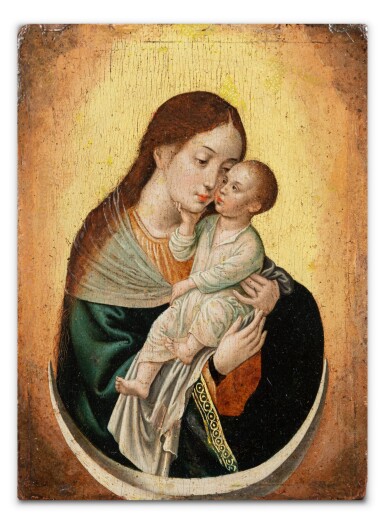Tableaux, Dessins, Sculptures 1300-1900
Tableaux, Dessins, Sculptures 1300-1900

From a Spanish Private Collection | Provenant d'une collection particulière espagnole
Circle of the Master of the Female Half-Lengths, Virgin and Child on the crescent moon | Entourage du Maître des demi-figures féminines, Vierge à l'Enfant sur un croissant de lune
Lot Closed
November 10, 02:12 PM GMT
Estimate
7,000 - 10,000 EUR
Lot Details
Description
Circle of the Master of the Female Half-Lengths
Virgin and Child on the crescent moon
Oil on panel, unframed
14,3 x 10,8 cm ; 5⅝ by 4¼ in.
____________________________________________
Entourage du Maître des demi-figures féminines
Vierge à l'Enfant sur un croissant de lune
Huile sur panneau, sans cadre
14,3 x 10,8 cm ; 5⅝ by 4¼ in.
Collection of Ramón Aras Jaúregui, Bilbao;
Acquired from the above by the present owner.
____________________________________________
Collection de Ramón Aras Jaúregui, Bilbao ;
Acquis auprès du précédent par le propriétaire actuel.
The Virgin and Child shown in a charmingly intimate pose is a theme that appears frequently in works of the Flemish Primitive school in the fifteenth and sixteenth centuries: deriving from a Byzantine prototype, it was taken up by many workshops, including that of Gérard David (1460-1523).
In fact, a handwritten inscription on the back of the present painting gives David’s name, no doubt attributing the painting to him. A similar work, a tondo, was sold in Amsterdam in 2011 (Sotheby’s sale 10 May 2011, lot 1, sold for 66,750 EUR) as Circle of Gérard David but has since been reattributed to the Master of the Female Half-Lengths by Suzanne Laemers (see RKD artwork no. 253953). While the identity of the master currently remains to be established, he is notably attributed with a Virgin and Child that is very close to the present painting (see RKD artwork no. 30749): through the Virgin’s gentle features, the hand gestures and the glances exchanged between the two figures, the artist expresses the tenderness and intimacy in the relationship between the Virgin and Child.
The iconography of the present painting is, however, somewhat different: here the holy figures are supported on a crescent moon, recalling the Litany of the Virgins and the Virgin of the Apocalypse. Originating in a theological debate that took place in the fifteenth and sixteenth centuries, this iconography shows the Virgin surrounded by the symbols that define her nature. Here it is the Virgin’s beauty that is evoked, referencing the Latin litany pulchra ut luna, or ‘as beautiful as the moon’. In particular, this iconography is represented in the Book of Hours (use of Rome) and inspired Flemish artists from the fifteenth century onwards: the Museum Boijmans Van Beuningen in Rotterdam has a Glorification of the Virgin by Geertgen tot sin Jans (1465-1495) dated circa 1480 (inv. 2450); various engravings have also survived, including one by the Monogrammist M, illustrating a book of hours, circa 1500-25 (British Museum, inv. 1868, 1114.207), in which the Virgin with the Child in her arms, surrounded by a nimbus, stands on a crescent moon supported by angels.
____________________________________________
Le motif de la Vierge à l’Enfant représenté dans une attitude de charmante intimité est récurrent dans les œuvres primitives flamandes aux XVe et XVIe siècles : dérivant d’un prototype byzantin, il est repris par nombre d’ateliers, parmi lesquels celui de Gérard David (1460-1523).
Une inscription manuscrite au dos du présent tableau mentionne d’ailleurs son nom, lui attribuant sans doute la paternité. Une œuvre similaire, en tondo, vendue à Amsterdam en 2011 (vente Sotheby’s du 10 mai 2011, lot 1, vendue 66,750 EUR) comme Entourage de Gérard David a néanmoins été ré-attribuée depuis au Maître des Demi-Figures par Suzanne Laemers (voir notice du RKD n° 253953). Si l’identité du maître reste à ce jour à déterminer, lui est attribuée notamment une Vierge à l’Enfant proche de la nôtre (voir notice du RKD 30749) : par la douceur des traits de la Vierge, le mouvement des mains et le jeu de regards, l’artiste traduit la tendresse et l’intimité des liens entre la Vierge et Jésus.
L’iconographie du présent tableau s’en distingue pourtant sensiblement : les figures saintes figurent ici portées par un croissant de Lune, se rapportant à la Litanie des Vierges et à la Vierge de l’Apocalypse. Issue d’un débat théologique ayant lieu aux XVe et XVIe siècles, elle s’attache à représenter la Vierge entourée des symboles qui définissent sa nature. C’est ici la beauté de la Vierge qui est évoquée, à travers la litanie latine pulchra ut luna, belle comme la lune. Cette iconographie est notamment représentée dans le Livre d’heures à l’usage de Rome et inspire dès le XVe siècle les artistes flamands : le musée Boijmans Van Beuningen à Rotterdam conserve une Glorification de la Vierge par Gérard de Saint-Jean (1465-1495) datée vers 1480 (inv. 2450) ; différentes gravures nous sont également parvenues, comme celle du Monogrammiste M illustrant un livre d’heures vers 1500-25 (British Museum, inv. 1868, 1114.207), où la Vierge portant l’Enfant, irradiant, se tient debout sur un croissant de lune porté par des anges…
